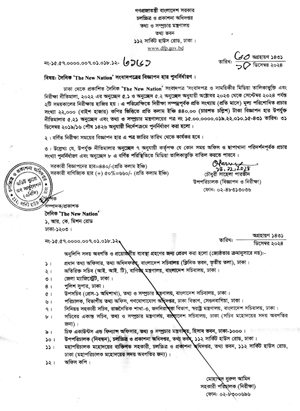Kamruzzaman Bablu :
The apparel industry in the country will be closely monitoring developments regarding import tariffs as Donald Trump’s new administration takes power in January next year.
The results of the policies will influence economies all over the world and determine the direction of the global apparel market.
Trump has historically promoted a more protectionist approach to trade, particularly with respect to countries that the United States has had significant trade deficits with.
This time, elected President Donald Trump has proposed a 60 per cent tariff on goods from China, between a 25 per cent and 100 percent tariff on goods from Mexico, and a 10 per cent to 20 per cent across-the-board tariff, it would significantly disrupt the apparel industry, both in the U.S. and globally.
If these tariffs are implemented, companies would face steep cost increases, which would either squeeze their profit margins or be passed on to consumers in the form of higher prices.
Besides, apparel brands may have raised prices in response to the increased tariffs.
This could reduce consumer demand for clothing, especially for mid-tier and budget brands, as buyers may react to higher prices by curbing their spending.
Bangladesh heavily relies on the US market. Any increase in import tariffs on Bangladeshi garments could lead to higher prices for consumers in the US, potentially reducing demand and impacting the profitability of both US retailers and Bangladeshi manufacturers.
Exporters of Bangladesh fear that a Trump presidency could also lead to challenges for multilateral trading institutions like the WTO and intensified global export competition.
Last year, Bangladesh exported $8.27 billion worth of garment items to the US, facing a 15.62 percent tariff.
During Trump’s presidency from 2017 to 2021, Bangladesh’s share of garment exports to the US fluctuated between 17 percent and 18.90 percent, according to the Bangladesh Garment Manufacturers and Exporters Association (BGMEA).
On the other hand, if the U.S. imposes higher tariffs on Chinese goods, many U.S. retailers and brands have sought alternative suppliers to avoid tariff costs.
This has led to a surge in demand for Bangladeshi apparel, as brands look to diversify their sourcing away from China.
Bangladesh, already a top apparel supplier to the U.S., has seen some positive impact as it benefits from its relatively low labor costs and established manufacturing infrastructure.
A prominent garment exporter to the USA from Bangladesh said Trump’s anti-China move could eventually benefit Bangladesh. If he imposes more tariffs on Chinese products, there is a possibility of work orders shifting to Bangladesh.
On the other hand, while the U.S. tariffs on other countries like China have presented new opportunities for Bangladesh’s apparel industry, there are several potential negative impacts as well.
If the U.S. imposes tariffs on Bangladeshi products, or if consumer demand shifts, Bangladesh’s apparel sector could face sudden order reductions and revenue loss.
As Bangladesh is not getting GSP facilities from the US, so without GSP, Bangladeshi apparel exports face standard tariffs in key markets, which makes them relatively more expensive compared to competitors who have duty-free access.
For example, countries like Cambodia, Pakistan, and several African nations enjoy duty-free access to the U.S. or EU under various trade agreements, putting Bangladesh at a disadvantage.
Trump’s victory introduces new variables for apparel suppliers and brands that rely heavily on global supply chains.
With potential shifts in trade policies, increased tariffs, and currency fluctuations, the apparel industry must brace for changes that could reshape sourcing strategies, impact profitability, and ultimately alter pricing structures for American consumers.
The U.S. tariffs on Chinese goods have created significant growth opportunities for Vietnam’s textile and apparel industry, allowing it to capture a larger share of the U.S. market.
Vietnam’s share of U.S. apparel imports has grown significantly, driven by this shift in sourcing.
This increased demand has helped many Vietnamese textile manufacturers grow and expand their operations, particularly in categories like apparel, footwear, and accessories that traditionally dominated Chinese exports.




